WHO数据完整性指南2019.10(中英对照)
数据完整性标准(ALCOA+CCEA原则)
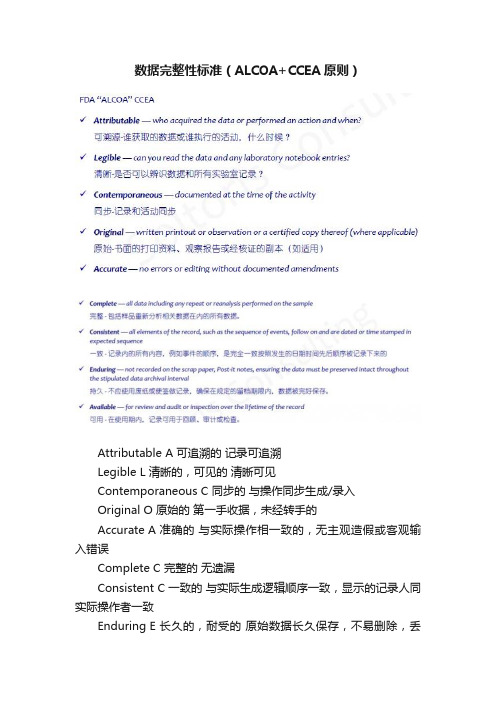
数据完整性标准(ALCOA+CCEA原则)Attributable A 可追溯的记录可追溯Legible L 清晰的,可见的清晰可见Contemporaneous C 同步的与操作同步生成/录入Original O 原始的第一手收据,未经转手的Accurate A 准确的与实际操作相一致的,无主观造假或客观输入错误Complete C 完整的无遗漏Consistent C 一致的与实际生成逻辑顺序一致,显示的记录人同实际操作者一致Enduring E 长久的,耐受的原始数据长久保存,不易删除,丢弃Available A 可获得的数据在审计时可见,不被隐藏ALCOA+CCEA 原则不仅是GMP 对记录完整性的要求,也是所有符合性审核对记录完整性的基本要求,是信用的基石。
由上文可得,ALCOA+CCEA 原则实际上就是对记录生成/录入、修改、存储、检索、备份、恢复和输出等数据生命周期内的所有操作的要求。
如果这些操作满足了以上原则,记录的完整性就满足要求了。
关于质量评估,指南提出采用ALCOA原则和ALCOA+原则等国际通行原则作为评估要求并需要设计相应的具体指标。
ALCOA原则是美国FDA于2007年在其指导原则《临床研究中使用的计算机化系统》中提出的,而ALCOA+原则是欧盟GCP监察官工作组(EU GCPIWG)于2010年在其发布的《关于临床试验中对电子源数据和转录成电子数据收集工具的期望的反馈书》中阐释的。
ALCOA原则是指Attributable(可归因性):可鉴别采集信息的来源,如受试者、输入者、外源数据等;Legible(易读性):采集的数据可被他人阅读和理解;Contemporaneous(同时性):数据应当在产生或观察的当时被记录,且在一定的时间窗内输入数据库,即数据的时间性标识;Original(原始性):数据首次被记录,或可以被追查到原始数据;Accurate(准确性):数据记录和计算、分析等转换过程是正确可靠的。
WHO 清洁验证新指南 WHO TRS 1019-53

WHO 在上个月发布新指南 WHO TRS 1019-53,英文全文303页,本文节选其中清洁验证部分,进行了翻译,供参考。
Appendix3Cleaningvalidation清洁验证Thetext of this appendix was previously published as:本附录的文本以前以下列形式发表:■■ Appendix 3: Cleaning validation. In: WHO Expert Committee onSpecificationsfor Pharmaceutical Preparations fortieth report. Geneva: World HealthOrganization; 2006: Annex 4 (WHO Technical ReportSeriesNo. 937;附录3:清洁验证。
在:世界卫生组织药物制剂规范专家委员会第四十次报告。
日内瓦世界卫生组织;2006:附件4(世卫组织技术报告系列,第937号;https://www.who.int/medicines/areas/quality_safety/quality_assurance/SupplementaryGMPValidati onTRS937Annex4.pdf?ua=1).1.Principle 原则1382.Scope 范围1383.General 概述1394.Cleaning validation protocols and reports 清洁验证方案和报告1395.Personnel 人员1426.Equipment 设备1427.Detergents 清洗剂1428.Microbiology 微生物1439.Sampling 取样14310.Analytical methods 分析方法14511.Establishing acceptable limits 确定可接受标准1461.Principle原则1.1The obxxxxjectives of good manufacturing practices (GMP) include the prevention of possiblecontamination and cross-contamination of pharmaceutical starting materials andproducts.药品生产质量管理规范(GMP)的目标包括防止可能的污染和药物原料和产品的交叉污染。
WHO GMP补充指南验证(中英对照)
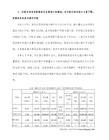
Annex 4附件4Supplementary guidelines on good manufacturing practices: validation 药品生产质量管理规范补充指南:验证1Introduction简介2Scope范围3Glossary术语4Relationship between validation and qualification验证和确认之间的联系5. Validation5.1. Approaches to validation验证方法5.2. Scope of validation验证范围5Qualification确认6Calibration and verification校准和核实7Validation master plan验证主计划8Qualification and validation protocols确认和验证方案9Qualification and validation reports确认和验证报告10Qualification stages确认程序11Change control变更控制12Personnel人员References参考文献Appendix 1附录1Validation of heating, ventilation and air-conditioning systems采暖、通风和空气净化系统的验证Appendix 2附录2Validation of water systems for pharmaceutical use制药用水系统的验证Appendix 3附录3Cleaning validation清洁验证Appendix 4附录4Analytical method validation分析方法验证Appendix 5附录5Validation of computerized systems计算机系统的验证Appendix 6附录6Qualification of systems and equipment系统和设备的确认Appendix 7附录7Non-sterile process validation非灭菌工艺的验证1. Introduction简介Validation is an essential part of good manufacturing practices (GMP). It is, therefore, an element of the quality assurance programme associated with a particular product or process. The basic principles of quality assurance have as their goal the production of products that are fit for their intended use. These principles are as follows:验证是药品生产管理规范(GMP)的一个重要组成部分;也正因如此,所以它同时也是产品或工艺的质量保证计划的一个不可或缺的要素。
VICH GCP GL9中英对照

兽药临床试验管理规范GOOD CLINICAL PRACTICEVICH GL9Translated by Chen Jianzhao2017.08Guangzhou General Pharmaceutical Research Institute (GPRI)Guidance for IndustryGOOD CLINICAL PRACTICEVICH GL9FINAL GUIDANCE(This document was revised on June 8, 2011 to update the contact information, add the Table of Contents, update hyperlinks, and minor formatting changes)This final guidance is intended to provide guidance on the design and conduct of all clinical studies of veterinary medicinal products in the target species submitted for approval to the European Union, Japan, and the United States.Comments and suggestions regarding this guidance should be sent to the Division of Dockets Management (HFA-305), Food and Drug Administration, 5630 Fishers Lane, Room 1061, Rockville, MD 20852. Comments may also be submitted electronically on the Internet at . All written comments should be identified with Docket No 99D-2406.For questions regarding this guidance document, contact Herman M. Schoenemann (HFV-100), Center for Veterinary Medicine, Food and Drug Administration, 7500 Standish Pl., Rockville, MD 20855, 240-276-8302, e-mail: herman.schoenemann@.U.S. Department of Health and Human Services Food and Drug Administration Center for Veterinary MedicineMay 9, 2001Final GuidanceINTRODUCTION1. GLOSSARY1.1. Adverse Event (AE)1.2. Applicable Regulatory Requirement(s)1.3. Audit1.4. Authenticated Copy 行业指南兽药临床试验管理规范VICH GL9最终指导(本文件于2011年6月8日修订,更新联系信息,添加目录,更新超链接和次要格式更改)本指南旨在为提交给欧盟,日本和美国的目标物种的兽药产品的所有临床研究的设计和实施提供指导。
OSHA中英文目录-1910--1926完整版
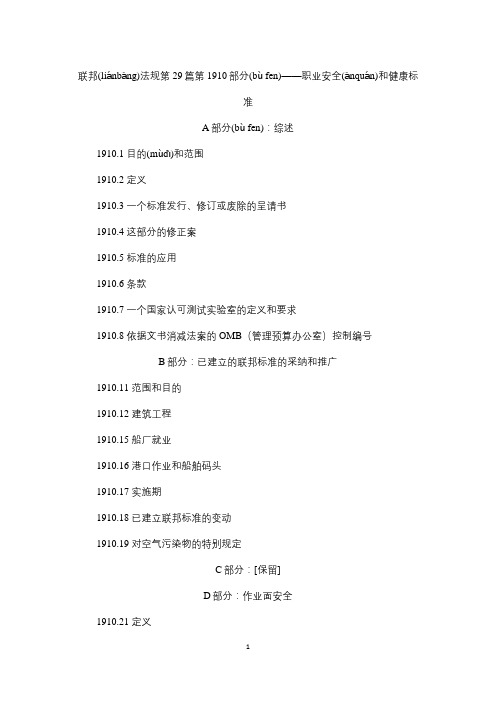
联邦(liánbāng)法规第29篇第1910部分(bù fen)——职业安全(ānquán)和健康标准A部分(bù fen):综述1910.1 目的(mùdì)和范围1910.2 定义1910.3 一个标准发行、修订或废除的呈请书1910.4 这部分的修正案1910.5 标准的应用1910.6 条款1910.7 一个国家认可测试实验室的定义和要求1910.8 依据文书消减法案的OMB(管理预算办公室)控制编号B部分:已建立的联邦标准的采纳和推广1910.11 范围和目的1910.12 建筑工程1910.15 船厂就业1910.16 港口作业和船舶码头1910.17 实施期1910.18 已建立联邦标准的变动1910.19 对空气污染物的特别规定C部分:[保留]D部分:作业面安全1910.21 定义1910.22 常规要求1910.23 地板和墙壁开口、漏洞的防护1910.24 固定工业楼梯1910.25 便携式木梯1910.26 便携式金属梯子1910.27固定式直梯1910.28 脚手架的安全要求1910.29 用手推动的移动梯、站和支架(塔)1910.30 其他作业面E部分:疏散设施1910.33 目录1910.34 范围和定义1910.35 符合NFPA 101 – 2000,生命安全规范1910.36 出口路线的设计和施工要求1910.37 出口路线的维护、保障措施和操作功能1910.38 应急预案1910.39 防火预案附录——出口路线、应急预案、防火预案F部分:动力平台、载人升降机和车载工作平台1910.66 建筑维护动力平台1910.67 车载升降和旋转工作平台1910.68 载人升降机G部分:职业健康和环境控制1910.94 通风(tōng fēng)1910.95 职业性噪声(zàoshēng)暴露1910.96 非电离辐射1910.98 实施(shíshī)期H部分:危险(wēixiǎn)物质1910.101 压缩(yā suō)气体(常规要求)1910.102 乙炔1910.103 氢气1910.104 氧气1910.105 一氧化二氮1910.106 易燃和可燃液体1910.107使用易燃和可燃材料喷涂1910.108 [保留]1910.109炸药及爆破剂1910.110液化石油气的储存和处理1910.111无水氨的储存和处理1910.112-1910.118[保留]1910.119 高度危险化学品过程安全管理1910.120 危险废物质的操作和应急处理1910.121 [保留]浸渍涂层操作1910.122 目录1910.123浸渍涂层操作:范围和定义1910.124浸渍涂层操作的一般要求1910.125 使用易燃和可燃液体浸渍涂层操作的额外要求1910.126特殊浸渍涂层操作的额外要求I部分:个人防护装置1910.132 常规要求1910.133 眼睛和面部防护1910.134 呼吸防护1910.135 头部防护1910.136 脚部防护1910.137 电气防护装置1910.138 手部防护附录A——补充信息的参考文献(非强制性)附录B——非强制性服从危害评价和个人防护装置选择指南J部分:常规的环境控制1910.141 环境卫生1910.142 临时劳工营1910.143 非水运输处理系统[保留]1910.144 标记物理危害的安全色代码1910.145 事故预防标识和标志的规格1910.146 需要许可的密闭空间1910.147 危险源控制K部分(bù fen):医疗和急救1910.151 医疗(yīliáo)服务和急救1910.152 [保留(bǎoliú)]L部分(bù fen):消防1910.155 范围(fànwéi). 适用于这部分的应用和定义1910.156 消防队移动式灭火设备1910.157 便携式灭火器1910.158 竖管和软管系统固定灭火设备1910.159 自动喷水系统1910.160 固定灭火系统,常规1910.161 固定式灭火系统,干粉1910.162 固定式灭火系统,气体灭火剂1910.163 固定式灭火系统,水喷雾和泡沫剂其他消防系统1910.164 火灾探测系统1910.165 员工报警系统附录A——消防附录B——国家共识标准附录C——消防参考如需进一步信息附录D——可用性的出版物通过引用并入1910.156节消防队附录E——防护服的测试方法M部分:压缩气体和压缩空气设备1910.166-1910.168 [保留]1910.169 空气接收器N部分:材料处理和储存1910.176 一般原料处理1910.177 维修多件和单件轮辋车轮1910.178 机动工业车辆1910.179 桥门式起重机1910.180 履带机车和汽车起重机1910.181 吊杆式起货设备1910.183 直升机1910.184 吊物机O部分:机械和机械防护1910.211 定义1910.212 所有机器的常规要求1910.213 木工机械要求1910.214 制桶业机械1910.215 砂轮机1910.216 在橡胶和塑料行业的磨粉机和轧光机1910.217 机械动力压力机1910.218 锻造机器1910.219 机械(jīxiè)传动装置P部分(bù fen):手持和便携式动力(dònglì)工具和其他(qítā)手持设备1910.241 定义(dìngyì)1910.242手持和便携式动力工具和设备,常规1910.243便携式动力工具的防护1910.244其他便携式工具和设备Q部分:焊接、切割和钎焊1910.251 定义1910.252 一般要求1910.253 氧燃料气体焊接和切割1910.254 电弧焊和切割1910.255 电阻焊接R部分:特色产业1910.261 纸浆,纸和纸板厂1910.262 纺织品1910.263 烘焙设备1910.264 洗衣房的机器和操作1910.265 锯木厂1910.266 伐木作业1910.268 电信1910.269 发电,输电和配电1910.272粮食处理设施S部分:电力综述1910.301 引言电力系统设计安全标准1910.302 电力应用系统1910.303 常规要求1910.304 布线设计和防护1910.305 接线方法,组件和用于一般用途的设备1910.306 特定用途设备和设施1910.307 危险源(分类)位置1910.308 特殊系统1910.309-1910.330 [保留]安全工作实践1910.331范围1910.332培训1910.333工作实践的选择和使用1910.334设备使用1910.335维护人员的安全防护1910.336-1910.360 [保留]与安全相关的维护要求1910.361-1910.380 [保留]特殊设备的安全要求1910.381–1910.398 [保留(bǎoliú)]定义(dìngyì) 1910.399 适用于本部分(bù fen)的定义附录(fùlù)A——参考文献附录(fùlù)B——有关说明资料附录C——表格,附注和图表T部分:商业潜水作业综述1910.401 范围和应用1910.402 定义个人要求1910.410潜水团队的资质一般操作程序1910.420安全操作手册1910.421潜水前程序1910.422在潜水过程中的程序1910.423潜水后程序具体操作程序1910.424配戴水肺的潜水1910.425水面供气潜水1910.426混合气潜水1910.427航行潜水装置程序和要求1910.430 装置记录存贮1910.440记录存贮要求附录A——可能禁止或限制暴露于高压条件的例子附录B——科学潜水指南附录C——§1910.401(a)(3)替代休闲潜水教练和潜水指南(强制性)U-Y部分:[保留]1910.901-1910.999 [保留]Z部分:有毒有害物质1910.1000 –空气污染物1910.1000 表Z-1 空气污染物的限值1910.1000 表Z-21910.1000 表Z-3 矿物性粉尘1910.1001-石棉1910.1001 附录A-OSHA参考方法(强制性)1910.1001 附录B-石棉取样和分析的详细程序(非强制性)1910.1001 附录C-定性和定量配合试验程序(强制性)1910.1001 附录D-医疗问卷(强制性)1910.1001 附录E-胸部X射线照片的阐释和分类(强制性)1910.1001 附录(fùlù)F-汽车制动器和离合器检查、拆卸、修理和组装的工作经验(jīngyàn)和工程控制(强制性的)1910.1001 附录(fùlù)G-石棉物质(wùzhì)技术信息(非强制性)1910.1001 附录(fùlù)H-石棉的医疗监测指南(非强制性)1910.1001 附录I-针对石棉的戒烟程序信息(非强制性)1910.1001 附录J-石棉的偏振光显微镜测试法(非强制性)1910.1002-煤焦油沥青等挥发物;术语解释1910.1003- 13种致癌物(硝基联苯等)1910.1004-甲萘胺1910.1005-[保留的]1910.1006-甲基氯甲醚1910.1007-二氯联苯(麦角二乙胺及其盐类)1910.1008-二氯甲醚1910.1009-β-萘胺1910.1010-联苯胺1910.1011-对氨基联苯1910.1012-乙撑亚胺1910.1013-β-丙内酯1910.1014-乙酰氨基芴1910.1015-二甲基黄1910.1016-二甲基亚硝胺1910.1017-氯乙烯1910.1017 附录A-补充医疗信息1910.1018-无机砷1910.1018 附录A-无机砷物质信息表1910.1018 附录B-物质技术指南1910.1018 附录C-医疗监测指南1910.1020访问雇员的曝光和病历1910.1020 附录A-释放员工的医疗记录信息到指定的代表样品授权书(非强制性)1910.1020 附录B-化学物质毒性作用登记(非强制性)1910.1025-铅1910.1025附录A-职业接触铅的物质资料表1910.1025 附录B-员工标准总结1910.1025 附录C-医疗监测指南1910.1025 附录D-定性适合性测试协议1910.1026-铬(VI)1910.1026附录A-铬(VI)1910.1027-镉1910.1027附录A-物质安全数据表(镉)1910.1027 附录B-镉的物质技术指南1910.1027 附录 C-定性和定量配合试验程序1910.1027 附录D-参考镉暴露的职业健康史专访1910.1027 附录(fùlù)E-在工作(gōngzuò)场所的氛围中的镉1910.1027 附录(fùlù)F-生物监测(jiān cè)的非强制性协议1910.1028 -苯1910.1028附录(fùlù)A-物质安全数据表,苯1910.1028 附录B-苯的物质技术指南1910.1028 附录C-针对苯的医疗监测指南1910.1028 附录D-苯的监视和测量程序的采样和分析方法1910.1028 附录E-定性和定量配合试验程序1910.1029 -焦炉排放1910.1029附录A -焦炉排放物质信息表1910.1029附录B -工业卫生和医疗监测指南1910.1030 - 血源性病原体1910.1030附录A - B型肝炎疫苗衰退(强制性)1910.1043 -棉尘1910.1043附录A -确定棉尘浓度的空气采样和分析方法1910.1043附录B-I - 呼吸问卷1910.1043附录B-II - 棉花产业的非纺织工人呼吸问卷1910.1043附录B-III –简略呼吸问卷1910.1043附录C - 正常男性和女性的肺功能预测表1910.1043附录D –针对棉尘标准的肺功能标准1910.1043 附录E-垂直分粒器等效协议1910.1044 -二溴氯丙烷1910.1044附录A - 二溴氯丙烷物质安全数据表1910.1044附录B - 二溴氯丙烷物质技术指南1910.1044附录C - 二溴氯丙烷医疗监控指南1910.1045 -丙烯腈1910.1045附录A - 丙烯腈物质安全数据表1910.1045附录B - 丙烯腈物质技术指南1910.1045附录C - 丙烯腈医疗监控指南1910.1045附录D - 丙烯腈的采样和分析方法1910.1047 -环氧乙烷1910.1047附录A - 环氧乙烷物质安全数据表(非强制性)1910.1047附录B - 环氧乙烷的物质技术指南(非强制性)1910.1047附录C - 环氧乙烷的医疗监控指南(非强制性)1910.1047附录D - 环氧乙烷的采样和分析方法(非强制性)1910.1048 -甲醛1910.1048附录A -甲醛物质安全数据表1910.1048附录B - 甲醛采样策略和分析方法1910.1048附录C -甲醛医疗监控1910.1048附录D - 非强制性医疗疾病问卷1910.1048附录E - 定性和定量的配合检验程序1910.1050 - 亚甲基1910.1050附录A - 4,4' - 二氨基物质数据表1910.1050附录B -丙二醛物质的技术指南1910.1050附录(fùlù)C - 丙二醛医疗(yīliáo)监控指南1910.1050附录(fùlù)D - 丙二醛监控(jiān kònɡ)和测量程序的采样与分析方法1910.1050附录(fùlù)E - 定性和定量的配合检验程序1910.1051 - 1,3-丁二烯1910.1051附录A - 1,3-丁二烯物质安全数据表(非强制性)1910.1051附录B - 1,3-丁二烯的物质技术指南(非强制性)1910.1051附录C - 1,3-丁二烯的医疗筛查和监测(非强制性)1910.1051附录D - 1,3-丁二烯的采样和分析方法(非强制性)1910.1051附录E - 呼吸器适合性检验程序(强制性)1910.1051附录F -医疗问卷(非强制性)1910.1052 -二氯甲烷1910.1052附录A -二氯甲烷物质安全数据表和技术准则1910.1052附录B-二氯甲烷医疗监测1910.1052附录C - 问题和答案 -在家具剥离时二氯甲烷控制1910.1096 -电离辐射1910.1200 - 危害通识1910.1200附录A -健康危害标准(强制性)1910.1200 附录B-物理标准(强制性)1910.1200 附录C-标志要素配置(强制性)1910.1200附录D - 安全数据表(强制性)1910.1200附录E-“商业秘密”的定义(强制性)1910.1200附录F-危害分级指南修订版:致癌性(非强制性)1910.1201-美国交通部标记、标牌和标签自留额1910.1450 - 实验室职业性暴露于危险化学品1910.1450附录A -国家研究委员会关于实验室化学卫生的建议(非强制性) 1910.1450附录B - 参考文献(非强制性)1926 –目录1926 A篇大纲1926.1- 目的与范围1926.2 - 安全与健康标准的差别1926.3 - 监督与权利1926.4 - 强制执行安全健康标准行政裁决的行为规范1926.5 - 依据文书削减法案的OMB监控数据1926.6 - 条款1926 B篇概述1926.10 - B篇范围1926.11 - 区别于103章节的有效范围1926.12 - 1950编号14重整计划1926.13 - 法定条款的解释1926.14 - 混合类行为的联邦合同1926.15 - 与服务合同法案及Walsh-Healey公共合同法案的关系1926.16 - 解释规则1926 C篇安全卫生总则1926.20 - 安全卫生总则1926.21 - 安全(ānquán)培训与教育1926.22 - 伤亡(shāngwáng)记录与报道1926.23 - 急救与医疗(yīliáo)护理1926.24 - 消防(xiāofáng)与防火1926.25 - 内务(nèiwù)处理1926.26 - 照明1926.27 - 公共卫生设备1926.28 - 个人防护用品1926.29 - 资质证书1926.30 - 造船及船舶维修1926.31 - [保留]1926.32 - 定义1926.33 - 员工医疗档案1926.34 - 疏散设施1926.35 - 员工紧急行动计划1926 D篇职业健康与环境控制1926.50 - 医疗卫生与急救护理1926.50 附录A 医疗卫生与急救护理1926.51 - 公共卫生1926.52 - 噪音1926.53 - 电离辐射1926.54 - 非电离辐射1926.55 - 气体、蒸气、废气、粉尘、烟雾1926.55 附录A 气体、蒸气、废气、粉尘、烟雾1926.56 - 照明1926.57 - 通风1926.58 -[保留]1926.59 - 危险通识1926.60 –亚甲基双苯胺1926.60 附录A 4-4'-亚甲基双苯胺物质数据表1926.60 附录B 丙二醛的技术规定1926.60 附录C 丙二醛医疗卫生监督指南1926.60 附录D 丙二醛监控测量过程的取样和分析方法1926.60 附录E 定性定量检测步骤1926.61 - 保留DOT标记、布告和标签1926.62 - 铅1926.62 附录A 职业接触铅的物质数据表1926.62 附录B 员工标准总结1926.62 附录C 医疗监测指南1926.62 附录D 定性定量检测步骤1926.64 - 高危化学品的安全生产管理1926.64 附录A 高危化学品,有毒物质,强活性(非强制性)物质列表1926.64 附录B块流程图和简化的工艺流程图(非强制性)1926.64 过程安全管理指导和建议(非强制性)1926.64 补充(bǔchōng)资料(非强制性)1926.65 - 危险废弃物处理和应急(yìng jí)响应1926.65 个人防护(fánghù)设备的测试方法1926.65 附录(fùlù)B 保护(bǎohù)防护装置级别的简介与分析1926.65 遵从性准则1926.65 附录D 参考文献1926.65 附录E 培训课程准则(非强制性)1926.66 - 喷烤漆房的设计与施工准则1926 E篇个人防护和救生设备1926.95 - 个人防护设备标准1926.96 - 职业足部保护1926.97 -[保留]1926.98 -[保留]1926.99 -[保留]1926.100 - 头部防护1926.101 - 听力防护1926.102 - 眼部面部防护1926.103 - 呼吸防护1926.104 - 安全带,救生索,系索1926.105 - 安全网1926.106 - 水上与近水工作1926.107 - 本篇适用的定义1926 F篇消防与防火1926.150 - 消防1926.151 - 防火1926.152 - 易燃液体1926.153 - 液化石油气1926.154 - 临时加热装置1926.155 - 本篇适用的定义1926.156 - 一般灭火系统1926.157 - 气态物质灭火系统1926.158 - 火警探测系统1926.159 - 雇主警报系统1926 G篇标志、信号和路障1926.200 - 事故防御标志与标签1926.201 - 信号1926.202 - 路障1926.203 - 本篇适用的定义1926 H篇物料搬运、存储、使用与处理1926.250 - 仓库通用总则1926.251 - 物料搬运装配设备1926.252 - 废物处置1926 I篇手动与电动1926.300 - 通用准则1926.301 - 手动工具(gōngjù)1926.302 - 电动工具1926.303 - 研磨(yánmó)砂轮与工具1926.304 - 木材(mùcái)加工1926.305 - 千斤顶杆和棘轮(jílún),螺钉,液压1926.306 - 空气(kōngqì)储罐1926.307 - 机械传动设备1926 J篇焊接和切割1926.350 - 气焊和切割1926.351 - 电弧焊和切割1926.352 - 防火1926.353 - 焊接,切割和加热过程中的通风和保护。
ISO14971-2019中文版

有关标准的自愿性质的解释,与合格评定有关的ISO特定术语和表达的 含义, 以及有关ISO遵守《技术性贸易壁垒(TBT )中的世界贸易组织
(WTO)原则》的信息,请访问 WWW I. SO。 组织IISO/前言html
的。
• 1范围·······································································································1 • 2 规范性弓 I用文件···················································································1 • 3术语和定义····························································································1 • 4 .7 风险管理体系的—般要求………………………………………………………… • 4.1 风险管理流程 ··7 ............…..……............…..…….......…..…·…..…...…..… • 4.2 管理职责···························································································8 • 4.3 9 人员能力............................................................................................ • 4.4 g 风险管理计划.............…………...........…...…..............…·……...…......... • 4.5 风险管理文件…..........…..……….........…...………........…·……..…········10 • 5 风险分析 ····························································································10 • 5.1 风险分析过程…..........…..……............…...……...............……...…·······10 • 5.2 预期用途和合理可预见的滥用……………………………………………·10 • 5.3 识别与安全有关的特性………………………………………………………··11 • 5.4 识别危害和危险情况…..………........…...………........…·……·············11 • 5.5风险估算··························································································11 • 6 风险评估····························································································12 • 7 风险控制·····························································································12 • 7.1 风险控制方案分析......…………..........…..……...….....…...………········13 • 7.2 实施风险控制措施.........…….............…..……...…...........……···········13 • 7.3 残留风险评估················································································13
WHO良好的数据和记录管理规范指南中文版

WHO良好的数据和记录管理规范指南中文版良好的数据和记录管理规范旨在确保组织能够有效地管理和保护其数据和记录。
这份草案提供了一套指南,以帮助组织制定和实施数据和记录管理策略,并确保其符合法律、法规和行业标准的要求。
1.引言1.1背景和目的1.2适用范围1.3定义2.数据和记录分类2.1数据分类2.2记录分类2.3敏感数据和记录分类3.数据和记录保护要求3.1访问控制3.2加密3.3备份和恢复3.4存储设备管理3.5数据传输3.6内部控制4.数据和记录保存期限4.1法律和法规要求4.2合同和协议要求4.3内部政策要求5.数据和记录销毁5.1销毁程序5.2销毁方法6.数据和记录审计6.1审计过程6.2审计记录6.3审计结果和建议7.数据和记录追溯7.1追溯流程7.2追溯记录和报告8.数据和记录安全培训8.1培训计划8.2培训内容8.3培训评估9.数据和记录管理责任9.1数据和记录拥有者责任9.2数据和记录管理团队责任9.3内部审计责任10.变更管理10.1变更控制流程10.2变更记录和审核11.风险管理11.1风险评估11.2风险控制措施12.提示和警告12.1数据和记录处理提示12.2数据和记录保护警告13.执行和监控13.1监控措施13.2故障处理13.3改进措施本指南的草案是根据国际数据和记录管理最佳实践编写的,旨在帮助组织确保其数据和记录管理规范符合国际标准。
组织可以根据自身的具体需求对本草案进行调整和完善,并制定符合其业务环境和需求的数据和记录管理策略。
良好的数据和记录管理是组织成功运营和合规的基础。
通过遵循本指南,组织可以建立一个高效和安全的数据和记录管理体系,从而提高运营效率、降低风险,并满足利益相关者的需求和期望。
WHO偏差处理和质量风险管理-中英文对照版-2013

3) Introduction 介绍
Among the essential elements of a well established Quality Management System (QMS), deviation handling plays a key role in assuring quality in products and by contributing to continuous improvement. Manufacturers are expected to “establish processes and define appropriate controls for measurement and analysis to identify nonconformities and potential non-conformities; defining when and how corrections, corrective actions, or preventive actions should be undertaken. These actions should be commensurate with the significance or risk of the nonconformity or potential nonconformity” (7).
目的是支持在疫苗和生物制品生产过程中有效及时地实施偏差管理相关的工具。
This guidance document is in line with International Conference on Harmonization (ICH) documents like ICH Q10 Pharmaceutical Quality System, ICH Q9 Quality Risk Management, and with WHO, FDA and EU requirements. It also incorporates the experience of experts and auditors in the field.
WHO 验证指南

限定世界卫生组织ORGANISATION MONDIALE DE LA SANTE优良制造规范(GMP) 辅助指南:验证有关对本文件的第一份草案的建议在第一轮的商讨中接受了审核,根据这些建议,南非比勒陀利亚卫生部医药控制委员会的Ms Joey Gouws 又对此文件进行了重重新起草。
如果对此文件有任何建议和/或发现需要改正之处,请与Dr S. Kopp 联系, 地址是Quality Assurance and Safety: Medicines, Essential Drugs and Medicines Policy,World Health Organization, 1211 Geneva 27, Switzerland, fax: (+41 22) 791 4730或电子邮件: kopps@who.int, with a copy to bonnyw@who.int, by 15 November 2003.©世界卫生组织2003保留所有权.本文件的提供是有限制的,例如,接受了此文件的个体或组织。
如果没有WHO的许可,这些个体或组织(包括组织成员和成员组织)之外的任何文件的形式或方法可能部分或全部没有被审核、提炼、引用、复制、传播、分发、翻译或可能不适用,本文件不能发布到网站上。
.如有任何许可的要求,请向Dr Sabine Kopp 提出,联系方式是Dr Sabine Kopp, Quality Assurance & Safety: Medicines (QSM), Department of Essential Drugs and Medicines Policy (EDM), World Health Organization, CH-1211 Geneva 27, Switzerland.Fax: (41-22) 791 4730; e-mails: kopps@who.int;本文件中所指定的以及陈述的材料并不意味着WHO的任何表述都代表了其辖区的任何国家、区域、城市、或地区的界线的法定状况。
DNV-OS-D101(2013-10)-中文版
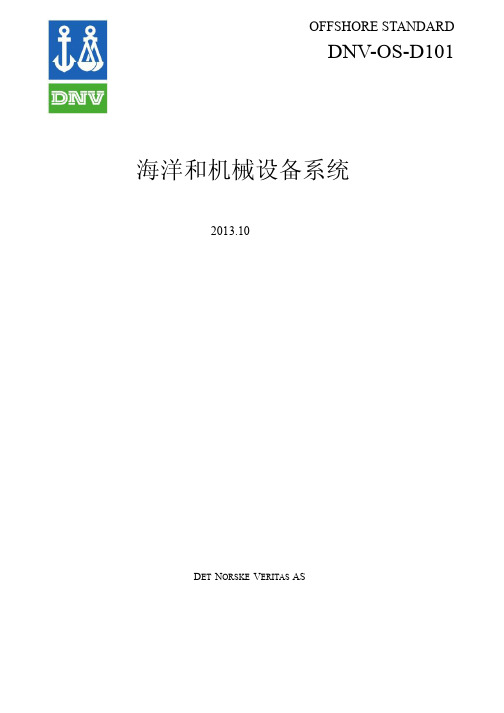
1 通用 ................................................................................................................................................................9 1.1 介绍 .....................................................................................................................................................9 1.2 范围.....................................................................................................................................................9 1.3 应用....................................................................................................................................................10 2 引用标准.......................................................................................................................................................10 2.1 通用................................................................................................................................................... 10 2.2 参考文件............................................................................................................................................10 3 信息参考.......................................................................................................................................................11 3.1 通用....................................................................................................................................................11
WHO数据完整性指南中文版

WHO数据完整性指南中文版
其次,指南强调了数据完整性的重要性。
数据完整性不仅能够提供准
确的信息用于决策,还能够增强公众对健康信息的信任度。
为了保证数据
的完整性,指南提供了一系列建议和要求。
其中包括:明确数据收集和分
析的目的和过程、制定数据质量控制计划、确保数据收集的一致性和准确性、建立合理的数据验证和核对机制、确保数据的保密性和安全性等。
指南还强调了数据报告的重要性。
数据报告是将数据转化为可理解和
可利用的信息的过程。
为了保证数据报告的准确性和一致性,指南提出了
一系列建议和要求。
其中包括:制定统一的数据报告标准、确保数据报告
的透明度和可验证性、提供充分的解释和背景信息、以及进行数据的可视
化和可解释分析等。
最后,指南还提供了数据完整性监测和评估的指导。
监测和评估是保
证数据完整性的重要环节,能够帮助各国及时发现和纠正数据完整性问题。
为了有效监测和评估数据完整性,指南提出了建议,包括:建立有效的数
据完整性监测和评估机制、制定监测和评估指标、进行数据完整性审核和
审查等。
总之,WHO数据完整性指南为各国提供了关于确保数据完整性的准则
和最佳实践。
它强调了数据完整性的重要性,提供了数据验证、核实、报
告和监测评估的指导。
通过遵循该指南,各国能够提高数据的准确性、可
靠性和一致性,为公共卫生政策的制定和决策提供可信赖的数据基础。
2019版患者安全十大目标解读

参考文献: [1] 孟普.医疗不良事件已成世界性问题[J].医院管理论坛,2007,24(11):28 --30. [2] 陈思仙 ,芮丽丽 ,彭德清,等.SHEL 模式在护理不良事件管理中的应用研 究[J].
★用药错误 美国每年有150万人遭遇用药错误。 ★手术差错 国内媒体曾报道,患者右脚有病,左脚却挨刀。
参考文献: [3] 张彩萍,李时敏,白晓兰,等.医院感染现患率调查分析[J].中华医院感染学杂
志,2011,21(14):2897-2899. [4] 徐凤霞,张兴华,王沐荣.医院感染现患率调查分析[J].中华医院感染学志,2010,
背景
中国医院协会患者安全目标(2017版)
中国医院协会常务副会长兼秘书长薛晓林发布了《中国 医院协会患者安全目标(2017版)》,并进行了解读。
背景
中国医院协会患者安全目标(2019版)
2019年5月31-6月1日,2019年中国医院质量大会在北京召开。 中国医院协会编制《患者安全目标》(2019版)是在历年患者安
目标一 正确识别患者身份
目标一正确识别患者身份
(一)
严格执行查对制度,确保对正确的患者实施正确的操作和治疗。识 别时应至少使用两种标识确认患者身份,如姓名、病案号、出生日期等, 但不包括患者的床号或病房号。
(二)
在实施输血、特殊用药等关键治疗时,应采用双人核对识别患者身份。
(三) 对术中患者、精神疾病、意识障碍、语言障碍等特殊患者,
二、提高病房与门诊用药的安全性 三、建立与完善在特殊情况下医务人员之
间的有效沟通,做到正确执行医嘱 四、建立临床实验室“危急值”报告制度 五、严格防止手术患者、部位及术式错误
WHO数据完整性指南良好的数据和记录规范中文版

WHO数据完整性指南良好的数据和记录规范中文版
引言:
良好的数据和记录规范对于保证数据的完整性和可靠性至关重要。
这份指南旨在提供一系列关键准则,以确保数据采集、记录和报告过程中的一致性和标准化,以减少数据错误和操纵风险,提高数据质量和可信度。
本指南适用于所有收集、记录和报告数据的机构和个人。
一、数据采集和记录
1.明确定义数据采集过程的目的、标准和方法,确保数据的一致性和可比性。
2.采用标准化的数据采集工具和表单,确保数据的准确性和一致性。
3.在数据采集过程中进行实时验证和纠正,以减少错误和遗漏。
4.遵守隐私和伦理规定,确保数据采集的合法性和保密性。
二、数据记录和存档
1.建立明确的数据记录和存档流程,确保数据的完整性和可追溯性。
2.使用可靠和安全的电子或纸质存储介质,确保数据的可靠性和持久性。
APIC《数据完整性指南》2019解读
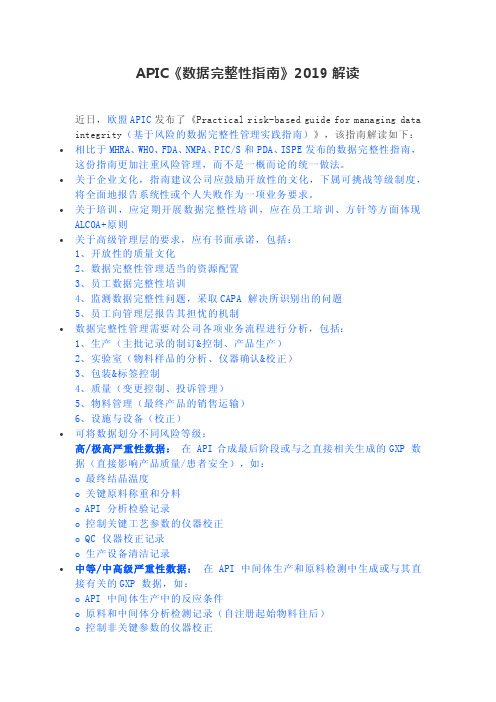
APIC《数据完整性指南》2019解读近日,欧盟APIC发布了《Practical risk-based guide for managing data integrity(基于风险的数据完整性管理实践指南)》,该指南解读如下:∙相比于MHRA、WHO、FDA、NMPA、PIC/S和PDA、ISPE发布的数据完整性指南,这份指南更加注重风险管理,而不是一概而论的统一做法。
∙关于企业文化,指南建议公司应鼓励开放性的文化,下属可挑战等级制度,将全面地报告系统性或个人失败作为一项业务要求。
∙关于培训,应定期开展数据完整性培训,应在员工培训、方针等方面体现ALCOA+原则∙关于高级管理层的要求,应有书面承诺,包括:1、开放性的质量文化2、数据完整性管理适当的资源配置3、员工数据完整性培训4、监测数据完整性问题,采取CAPA 解决所识别出的问题5、员工向管理层报告其担忧的机制∙数据完整性管理需要对公司各项业务流程进行分析,包括:1、生产(主批记录的制订&控制、产品生产)2、实验室(物料样品的分析、仪器确认&校正)3、包装&标签控制4、质量(变更控制、投诉管理)5、物料管理(最终产品的销售运输)6、设施与设备(校正)∙可将数据划分不同风险等级:高/极高严重性数据:在 API合成最后阶段或与之直接相关生成的GXP 数据(直接影响产品质量/患者安全),如:o 最终结晶温度o 关键原料称重和分料o API 分析检验记录o 控制关键工艺参数的仪器校正o QC 仪器校正记录o 生产设备清洁记录∙中等/中高级严重性数据:在 API中间体生产和原料检测中生成或与其直接有关的GXP 数据,如:o API 中间体生产中的反应条件o 原料和中间体分析检测记录(自注册起始物料往后)o 控制非关键参数的仪器校正o API 中间体生产中控记录∙低严重性数据:具有 GXP 相关性但不直接与原料检测、 API 中间体生产或检测,或 API最终阶段生产或检测有关的 GXP数据,如:o 不直接影响操作,未在批生产记录(BPR)或检验方法中描述的记录o 物料位置和转移(对温度不敏感)或物料转移请求o 废弃培养基处理的灭菌器GXP 数据o 操作员进出生产区域o 在工艺或系统或设备开发期间验证或确认之前生成的 GXP 数据o 排班表o 计划数据(生产计划)o 交接班日志o 时间和考勤信息(时间和考勤系统可不确认,但可能会在调查中使用)o 安全培训o 起始物料之前的化学品分析o 仅供过程控制参考的信息∙关于系统分类,可按照数据的不同形式分为6类系统:第1类:非电子系统。
WHO《数据完整性指南》-2021(中英文对照版)

WHO《数据完整性指南》-2021(中英⽂对照版)3⽉29⽇,WHO发布了第 55 届药物制剂规范专家委员会(ECSPP)技术报告TRS No.1033,其中包含新的《数据完整性指南》,翻译如下,分享给⼤家!Guideline on data integrity数据完整性指南1. Introduction and background介绍和背景1.1. In recent years, the number ofobservations made regarding the integrity of data, documentation and recordmanagement practices during inspections of good manufacturingpractice (GMP) (2),good clinical practice (GCP), good laboratory practice (GLP) and GoodTrade andDistribution Practices (GTDP) have been increasing. The possible causes forthismay include近年来,在对良好⽣产规范(GMP)(2)、良好临床规范(GCP)、良好实验室规范(GLP)和良好贸易和分销规范(GTDP)的检查过程中,对数据完整性、⽂件和记录管理规范的缺陷数量持续增加。
可能的原因包括:(ⅰ) reliance on inadequate human practices;依赖于不适当的⼈员操作;(ⅱ)poorly defined procedures;规定糟糕的规程(ⅲ)resource constraints;资源限制(ⅳ) the use of computerized systems that are not capable of meetingregulatory requirements orare inappropriately managed and validated (3, 4);使⽤不满⾜法规要求,或管理/验证不当的计算机系统(3,4);(ⅴ) inappropriate and inadequate control of data flow; and不适当和不充分的数据流控制;和(ⅵ)failure to adequately review and manage original data and records.未能充分审核和管理原始数据和记录。
(参考资料)WHO量表使用说明
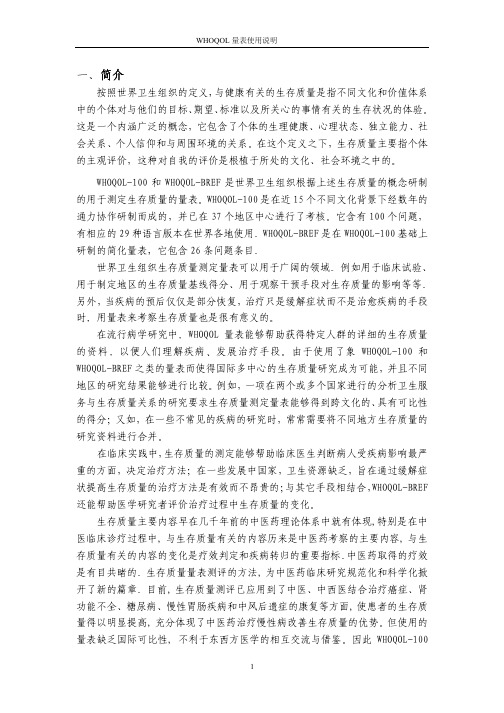
WHOQOL 量表测定的是最近两周的生存质量的情况 但在实际工作中 根据 工作的不同阶段的特殊性 量表可以考察不同长度的时间段的生存质量 如 评 价一些慢性疾病如关节炎 腰背痛患者的生存质量 可调查近四周的情况 在接 受化疗的病人的生存质量评价中 主要根据所要达到的疗效或产生的副作用来考 虑时间框架
mno95plGpR S *
TUqr st uv wx y z (
wxqr {N| }~ JKh
对简表进行信度 效度等计量心理指标考核 发现简表具有较好的内部一致 性 良好的区分效度和结构效度 简表各个领域的得分与 WHOQOL-100 量表相应 领域的得分具有较高的相关性 Pearson 相关系数最低为 0.89 社会关系领域 最高等于 0.95 生理领域
总之 WHOQOL-BREF 在测量与生存质量有关的各个领域的得分水平上能够替 代 WHOQOL-100 它提供了一种方便 快捷的测定工具 但是它不能测定每个领 域下各个方面的情况 因此 在选择量表时 综合考虑量表的长短和详细与否是 最关键的
FGVWXY !
Z[TU # %
\]^_ &
>?`aFGXY bcdef ('
bcgh ij k6lG #
:;<=>?@ABC3 $'
DE6 )# FGHI
JKHI
LMFGNOPQRS *
3 9 ++ TU
国际疾病分类-ICD概述
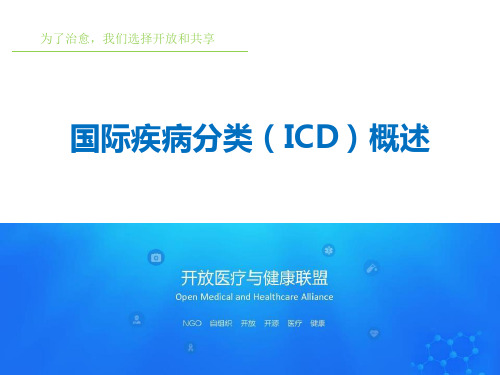
WHO 发布的ICD-10 共有22章,包含约1.4万疾病与相 关健康问题分类术语
章节 类目
亚目
扩展版
11
随着医疗水平发展,医学信息进步,医疗AI各项应用推广, ICD-10 日渐难以满足行业变化的需求
ICD-10使用受限的两个核心问题
知识老化
结构简单
未收录最新医学知识 • 如传染病、神经系统疾病、呼吸系
1990-1938年 • 1899 年,国际统计协会年会上宣布所有北美统计机构、部分南美统计机构和部分欧洲 持续修订 统计机构已应用了1893年制定的系统死亡原因统一命名法。基本同意美洲公共卫生协 会在1898年渥太华会议上提出的每10年修订一次《国际死亡原因分类》的建议。从这 后《国际死亡原因分类》的修订开始进入常态化的工作,1900年8月第一届修订大会 有26个国家的代表出席本次会议,大会通过《〈国际死亡原因分类〉修订决议》,修 订后的《国际死亡原因分类》包含35项大类,179项子类目。此后,1909 年、1920 年、1929 年和1938 年均如期召开了《国际死亡原因分类》的修订大会。
1993年 • 1993年5月,国家标准化管理委员会批准等效采用ICD-9编制的疾病分类国家标准: GB/T14396-1993,并于1994年1月1日正式实施。
2002年
• 2001 年11 月20 日,原国家卫生部卫医发[2001]286号《关于修订下发住院病案首 页的通知》,明确要求“住院病案首页填写要采用ICD-10 和ICD-9-CM-3”。同年, 国家标准化管理委员会发布了疾病分类与代码GB/T14396-2001 修订的标准,等效采 用世界卫生组织WHO(ICD-10)《疾病和有关健康问题的国际统计分类》(第10次 修订版),并从2002年6月1日实施。
- 1、下载文档前请自行甄别文档内容的完整性,平台不提供额外的编辑、内容补充、找答案等附加服务。
- 2、"仅部分预览"的文档,不可在线预览部分如存在完整性等问题,可反馈申请退款(可完整预览的文档不适用该条件!)。
- 3、如文档侵犯您的权益,请联系客服反馈,我们会尽快为您处理(人工客服工作时间:9:00-18:30)。
QAS/19.819GUIDELINE ON DATA INTEGRITY数据完整性指南(October 2019)2019 年10 月1. INTRODUCTION AND BACKGROUND前言与背景1.1. Data governance and data integrity (DI) are important elements in ensuring the reliability of data and information obtained in production and control of pharmaceutical products. The data and information should be complete as well as being attributable, legible, contemporaneous, original and accurate, commonly referred to as meeting “ALCOA” principles.数据管理与数据完整性(DI)是确保药品生产和检测期间所获得的数据和信息可靠性的重要要素。
这些数据和信息应完整,同时具有可追溯性、清晰、同步、原始和准确,一般称为符合“ALCOA”原则。
1.2. In recent years, the number of observations made regarding the integrity of data, documentation and record management practices during inspections of good manufacturing practice (GMP), good clinical practice (GCP) and good laboratory practice (GLP) has been increasing. Possible causes for this may include (i) too much reliance on human practices; (ii) the use of computerized systems that are not appropriately managed and validated; and (iii) failure to adequately review and manageoriginal data and records.近年,在 GMP、GCP 和 GLP 检查中,数据完整性、文件记录管理规范性方面的缺陷数量大大上升。
可能的原因大致包括(1)太过依赖人员操作,(2)使用了未进行恰当管理和验证的计算机化系统,以及(3)未充分审核和管理原始数据与记录。
1.3. Quality risk management (QRM), control strategies and sound scientific principles are required to mitigate such risks. Examples of controls may include, but are not limited to:降低此类风险需要有质量风险管理(QRM)、控制策略和科学合理原则。
控制实例可包括但不仅限于:•the establishment and implementation of a DI policy;•制订和实施 DI 方针;•the establishment and implementation of procedures that willfacilitate compliance with DI requirements and expectations;•制订和实施有利于符合 DI 要求和预期的程序;•adoption of a quality culture within the company that encourages personnel to be transparent about failures which includes a reporting mechanism;•在公司内推行质量文化,鼓励员工坦白失败,包括报告机制;•application of QRM with identification of all areas of risk to DI through data integrity risk assessment (DIRA) and implementation of appropriate controls to eliminate or reduce risks to an acceptable level throughout the life cycle of the data;•应用 QRM,通过数据完整性风险评估(DIRA)识别所有领域的 DI 风险,在数据整个生命周期中实施适当控制消除或降低风险至可接受水平;•ensuring sufficient resources to monitor compliance with DI policies and procedures and processes, and facilitate continuous improvement;•确保有足够的资源监测 DI 方针以及程序和流程遵守情况,促进持续改进;•provision of necessary training for personnel in, for example, good practices (GXP), computerized systems and DI;•为员工提供必要的培训,如,优良规范(GXP)、计算机化系统和 DI;•implementation and validation of computerized systems appropriate for their intended use;•根据其既定用途实施和验证计算机化系统;•definition and management of appropriate roles and responsibilities for quality agreements and contracts entered into by contract givers and contract acceptors.•作为合同委托方或接受方签署的质量协议和合同中适当角色与职责的定义和管理。
2. SCOPE范围2.1. This guideline provides information, guidance and recommendations to facilitate compliance with DI, GXP in documentation and record keeping requirements.本指南提供促进 DI、GXP 在文件和记录保存要求方面的合规性信息、指南和建议。
2.2. The scope of this guideline is designated as ‘GXP’. It does not, however, cover medical devices.本指南的范围规定为“GXP”。
但并不覆盖医疗器械。
2.3. Where possible, this guideline has been harmonised with other published documents. The guideline should be read with other WHO GXP guidelines and publications.如可能,本指南已与其它已发布文件保持统一。
本指南应与其它 WHO GXP 指南和出版物联合解读。
2.4. In line with the current approach in GMP, it recommends a risk-based approach over the life cycle of data. DIRA should be carried out in order to identify and assess areas of risk.根据 GMP 中的当前方法,建议对数据生命周期采取基于风险的方法。
应执行 DIRA 以识别和评估风险领域。
2.5. The principles of this guideline apply to contract givers and contract acceptors. Contract givers are ultimately responsible for the integrity of data provided to them by contract acceptors. Contract givers should therefore ensure that contract acceptors comply with the principles contained in this guideline.本指南的原则适用于合同委托方和合同接受方。
合同委托方最终对合同接受方提交给他们的数据的完整性负责。
委托方因此应确保合同接受方符合本指南所含原则。
2.6. Efficient risk-based controls and review of data and documents should be identified and implemented. The effectiveness of thecontrols should be verified.应识别并实施对数据和记录的基于风险的有效控制与审核。
控制的有效性应进行验证。
3. GLOSSARY 术语(Note: This section will be updated)(注:本部分将进行更新)The definitions given below apply to the terms used in these guidelines. They may have different meanings in other contexts. 以下定义适用于本指南所述术语。
可能与其它语境含义有所不同。
ALCOA.A commonly used acronym for “attributable, legible, contemporaneous, original andaccurate”. 常用术语,代表“可追溯性、清晰、同步、原始和准确”。
